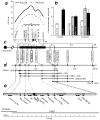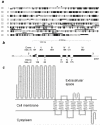Positional cloning of the mouse saccharin preference (Sac) locus
- PMID: 11555487
- PMCID: PMC3644801
- DOI: 10.1093/chemse/26.7.925
Positional cloning of the mouse saccharin preference (Sac) locus
Abstract
Differences in sweetener intake among inbred strains of mice are partially determined by allelic variation of the saccharin preference (Sac) locus. Genetic and physical mapping limited a critical genomic interval containing Sac to a 194 kb DNA fragment. Sequencing and annotation of this region identified a gene (Tas1r3) encoding the third member of the T1R family of putative taste receptors, T1R3. Introgression by serial backcrossing of the 194 kb chromosomal fragment containing the Tas1r3 allele from the high-sweetener-preferring C57BL/6ByJ strain onto the genetic background of the low-sweetener-preferring 129P3/J strain rescued its low-sweetener-preference phenotype. Polymorphisms of Tas1r3 that are likely to have functional significance were identified using analysis of genomic sequences and sweetener-preference phenotypes of genealogically distant mouse strains. Tas1r3 has two common haplotypes, consisting of six single nucleotide polymorphisms: one haplotype was found in mouse strains with elevated sweetener preference and the other in strains relatively indifferent to sweeteners. This study provides compelling evidence that Tas1r3 is equivalent to the Sac locus and that the T1R3 receptor responds to sweeteners.
Figures



References
-
- Adler E, Hoon MA, Mueller KL, Chandrashekar J, Ryba NJ, Zuker CS. A novel family of mammalian taste receptors. Cell. 2000;100:693–702. - PubMed
-
- Bachmanov AA, Reed DR, Ninomiya Y, Inoue M, Tordoff MG, Price RA, Beauchamp GK. Genetic locus on mouse chromosome 4 influencing taste responses to sweeteners (Abstract) Chemical Senses. 1997a;22:642.
Publication types
MeSH terms
Substances
Associated data
- Actions
Grants and funding
LinkOut - more resources
Full Text Sources
Other Literature Sources
Molecular Biology Databases

